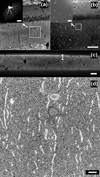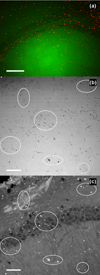X-ray microscopy as an approach to increasing accuracy and efficiency of serial block-face imaging for correlated light and electron microscopy of biological specimens
- PMID: 25392009
- PMCID: PMC4415271
- DOI: 10.1017/S1431927614013579
X-ray microscopy as an approach to increasing accuracy and efficiency of serial block-face imaging for correlated light and electron microscopy of biological specimens
Abstract
The recently developed three-dimensional electron microscopic (EM) method of serial block-face scanning electron microscopy (SBEM) has rapidly established itself as a powerful imaging approach. Volume EM imaging with this scanning electron microscopy (SEM) method requires intense staining of biological specimens with heavy metals to allow sufficient back-scatter electron signal and also to render specimens sufficiently conductive to control charging artifacts. These more extreme heavy metal staining protocols render specimens light opaque and make it much more difficult to track and identify regions of interest (ROIs) for the SBEM imaging process than for a typical thin section transmission electron microscopy correlative light and electron microscopy study. We present a strategy employing X-ray microscopy (XRM) both for tracking ROIs and for increasing the efficiency of the workflow used for typical projects undertaken with SBEM. XRM was found to reveal an impressive level of detail in tissue heavily stained for SBEM imaging, allowing for the identification of tissue landmarks that can be subsequently used to guide data collection in the SEM. Furthermore, specific labeling of individual cells using diaminobenzidine is detectable in XRM volumes. We demonstrate that tungsten carbide particles or upconverting nanophosphor particles can be used as fiducial markers to further increase the precision and efficiency of SBEM imaging.
Keywords: upconverting nanoparticles.
Figures





References
-
- Auinger S, Small JV. Correlated light and electron microscopy of the cytoskeleton. Methods in cell biology. 2008;88:257–272. - PubMed
-
- Deerinck T, Bushong E, Lev-Ram V, Shu X, Tsien R, Ellisman M. Enhancing serial block-face scanning electron microscopy to enable high resolution 3-D nanohistology of cells and tissues. Microscopy and Microanalysis. 2010;16(SupplementS2):1138–1139.

